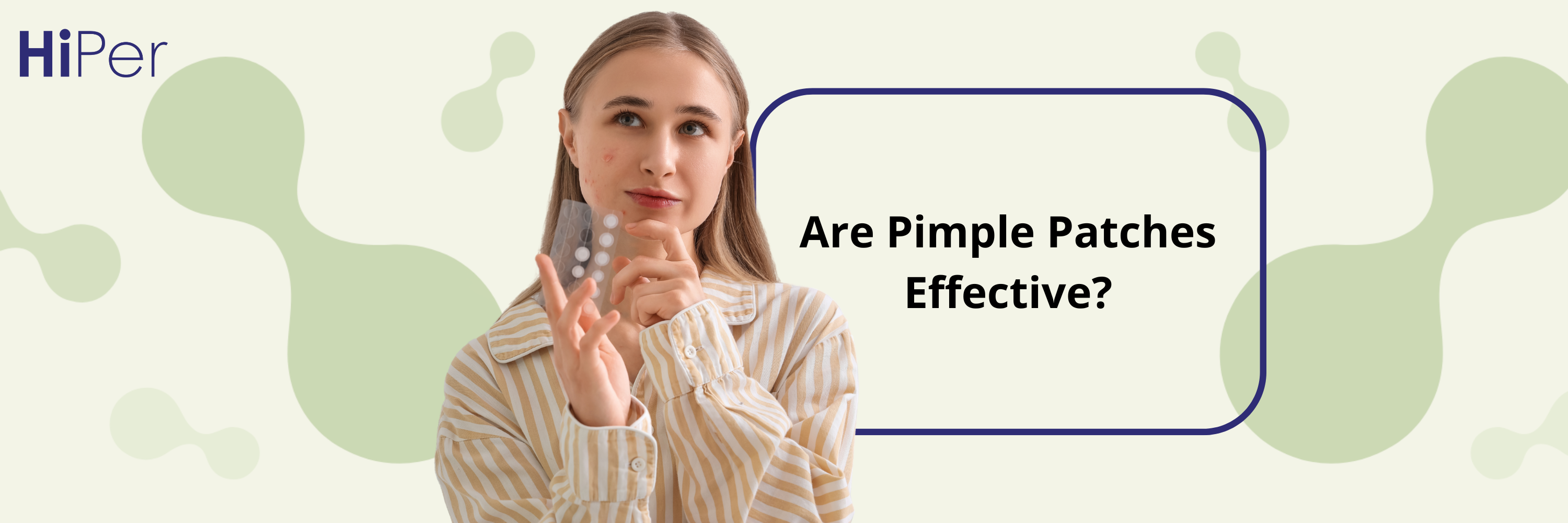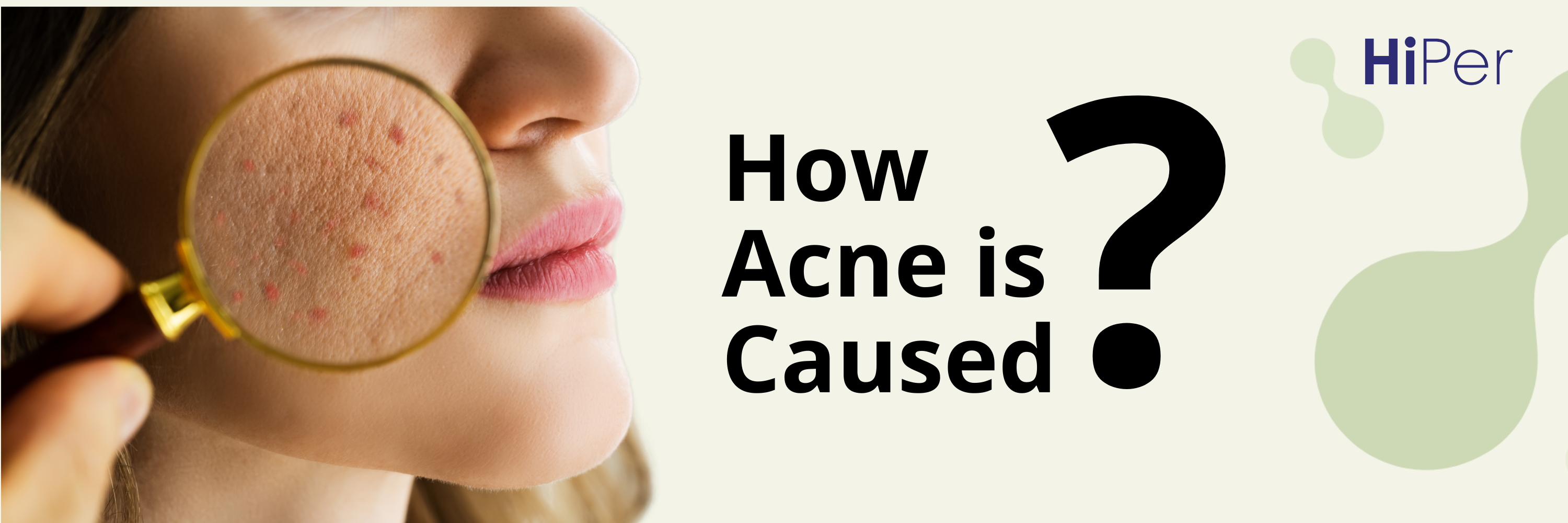
Are Pimple Patches Effective?
Understanding Acne: Causes, Types & Tips to Manage It
Acne is more than just a teenage concern — it’s a common skin condition that affects people of all ages, genders, and skin types. At HiPer Skin, we believe that understanding your skin is the first step toward healthier skin. Let’s dive deep into what causes acne, the different types you might encounter, and how to manage it effectively.
What Is Acne?
Acne occurs when pores become clogged with excess oil (sebum), dead kin cells, and sometimes bacteria. While it most commonly appears on the face, acne can also affect the back, chest, shoulders, and even the arms.
It’s important to remember: acne is not just a cosmetic issue. It can impact self-esteem, mental health, and quality of life. Addressing it holistically, with knowledge and patience, is key.
Common Causes of Acne
Several factors contribute to the development of acne. Understanding these can help you manage breakouts more effectively:
1. Excess Sebum Production - Sebaceous glands naturally produce oil to keep skin moisturized, but overproduction can lead to clogged pores.
2. Dead Skin Cell Buildup - Skin naturally sheds dead cells. If these aren’t cleared away properly, they can clog pores and contribute to acne.
3. Hormonal Changes - Fluctuations in hormones — during puberty, menstruation, pregnancy, or stress — can trigger or worsen acne.
4. Bacterial Growth - Cutibacterium acnes (formerly Propionibacterium acnes) is a bacteria found on the skin that can multiply in clogged pores and cause inflammation.
5. Diet & Lifestyle - While diet alone doesn’t cause acne, high-glycemic foods, dairy, and certain lifestyle factors like poor sleep or stress may play a role.
6. Incorrect Skincare or Makeup - Using comedogenic products (those that clog pores), not cleansing properly, or over-exfoliating can all irritate acne-prone skin.
Types of Acne
Acne comes in different forms — recognizing which type you have can help guide your approach to managing it:
- Whiteheads: Closed clogged pores beneath the skin’s surface.
- Blackheads: Open clogged pores with oxidized debris, appearing dark.
- Papules: Small, red, inflamed bumps.
- Pustules: Similar to papules, but filled with pus.
- Nodules: Deep, painful lumps under the skin.
- Cysts: Large, pus-filled lesions that can scar.
Each type may require different levels of care and attention.
Tips to Manage Acne-Prone Skin
Managing acne isn’t about achieving perfect skin overnight — it’s about consistent care and making small changes that protect and heal your skin over time.
✔ Stay Consistent With Your Skincare Routine
Gentle cleansing, non-comedogenic moisturizers, and sun protection are essential. Avoid switching products frequently — your skin needs time to adjust.
✔ Don’t Over-Cleanse or Over-Exfoliate
Too much cleansing or exfoliation can strip your skin, triggering more oil production and inflammation.
✔ Hands Off Your Face
Touching your face spreads bacteria and can worsen inflammation or lead to scarring.
✔ Check Your Diet
While there’s no one-size-fits-all acne diet, reducing processed sugars and keeping a food journal may help you identify triggers.
✔ Manage Stress
Stress hormones can stimulate oil glands and worsen breakouts. Prioritize sleep, exercise, and mindfulness when possible.
✔ Consult a Dermatologist for Persistent Acne
For moderate to severe acne or scarring, professional advice and treatment may be necessary.
Acne and Mental Health: The Unspoken Connection
Acne can take a toll on mental well-being. Feelings of frustration, embarrassment, or low self-esteem are completely valid. You’re not alone, and it’s okay to seek support — from dermatologists, therapists, or communities that understand the journey.
Pimple Patches: What They Are and How They Help with Acne
If you’ve ever wished for a simple, overnight solution to calm an angry pimple — you’re not alone. Enter: pimple patches. These tiny, translucent stickers have become a staple in acne care, and for good reason. They’re discreet, effective, and often a game-changer for people with acne-prone skin.
What Are Pimple Patches?
Pimple patches are small adhesive stickers made primarily of hydrocolloid, a material that’s been used in wound care for decades. Hydrocolloid absorbs moisture — in the case of acne, that means oil, pus, and fluid from inflamed pimples. Some patches also include active ingredients like salicylic acid, tea tree oil, or niacinamide to further soothe the skin and speed up healing.
These patches work best on whiteheads, pustules, or surface-level pimples — but newer, targeted patches can also address deeper or hormonal breakouts.
How Do Pimple Patches Work?
✅ They Absorb Gunk - The hydrocolloid draws out fluid and impurities from the pimple, reducing its size and redness — often overnight.
✅ They Create a Protective Barrier - Patches prevent you from picking at your skin (a major cause of scarring) and protect the pimple from dirt and bacteria.
✅ They Promote Faster Healing - By maintaining a moist environment and shielding the spot from external irritants, pimple patches help accelerate the skin’s healing process.
✅ They’re Great for Day or Night Use - Most pimple patches are ultra-thin and can be worn under makeup during the day, or used as an overnight treatment while you sleep.
Who Should Use Pimple Patches?
Pimple patches are ideal for:
- People who pick at their acne
- Those who want to reduce visible whiteheads quickly
- Individuals with occasional breakouts that need a spot treatment
- Anyone looking for a fuss-free acne solution that doesn’t dry out the surrounding skin
Tips for Using Pimple Patches Effectively
- Cleanse your skin thoroughly before applying the patch.
- Apply to dry skin — oil or moisture can affect adhesion.
- Leave the patch on for at least 6–8 hours, or until it turns white or cloudy.
- Follow up with a gentle skincare routine after removal — don’t scrub or exfoliate the area immediately.
Pimple Patches Aren’t a Cure-All — They’re Part of a Routine
While pimple patches are excellent for managing individual breakouts, they work best alongside a thoughtful skincare regimen that targets the root causes of acne, such as excess oil production, bacterial growth, or inflammation.
HiPer Skin: Formulated for Acne-Prone Skin
At HiPer Skin, we’ve created high-performance, science-backed skincare designed specifically for acne-prone and sensitive skin. While we don’t currently offer pimple patches (yet!), our lineup is built to complement your acne-fighting journey from every angle.
🧼 HiPer Skin Cleanser
Gently remove dirt, oil, and impurities without stripping your skin barrier.
🌾 HiPer Rice Microfliant
A gentle, water-activated exfoliating powder with rice bran, enzymes, and biotics to unclog pores and smooth skin without irritation. Use 2–3 times a week for glowing, refined skin texture.
💧 HiPer Skin Biome+ Moisturizer
Hydrates and balances your skin microbiome — essential for calming inflammation.
💥 HiPer Skin Targeted Acne Serum
Powered with multi-active ingredients like niacinamide, azelaic acid, and biotics to reduce blemishes and prevent future breakouts.
🌿 HiPer Skin Spot Corrector Gel
A fast-acting treatment that targets blemishes and visibly reduces redness.
If you’re using pimple patches for spot control, these products can support your overall acne management with consistency and long-term results.
Final Thoughts
Pimple patches are more than a trend — they’re a legit tool in the acne toolkit. But to really take charge of your skin, pair smart spot treatments with high-performance daily care. Your skin deserves both quick fixes and long-term love.
Ready to level up your acne care?
Explore HiPer Skin’s acne-friendly lineup today.


